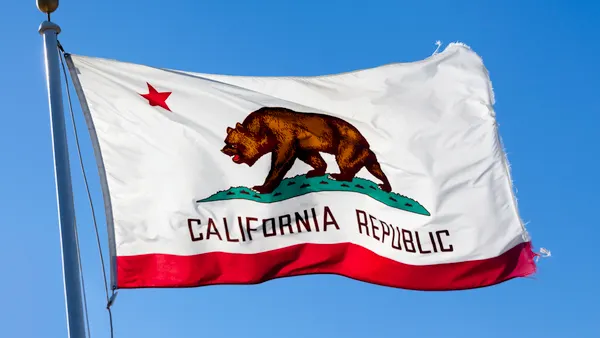Dive Brief:
-
The California Public Utilities Commission on Wednesday issued a proposed decision opting not to expand on and adopt new fixed charges for residential customers, amid concerns that IOUs have not planned adequate customer outreach to ensure a smooth roll-out.
-
Given the "checkered" history of default fixed charges, the CPUC is "gravely concerned with the potential for a negative customer reaction," especially since the utilities have acknowledged the risk of backlash to a fixed charge, according to the proposal.
-
The earliest that commissioners can vote on the proposed decision is at the agency's March 12 meeting.
Dive Insight:
California regulators began considering the possibility of adopting a fixed charge as part of a broader effort to reform Pacific Gas & Electric, Southern California Edison and San Diego Gas & Electric residential rate designs.
All three IOUs filed applications for residential default time-of-use rates in December, 2017. As part of those applications, PG&E and SDG&E proposed adding fixed charges of $6.37 for their low income customers and $10 for the rest, while SCE requested authority to increase its pre-existing fixed charge from less than $1 to $6.68 per month for non-low income customers.
In their applications, two of the IOUs also sought to modify the minimum bill amounts they charge residential customers, that in 2015 were set at $10 per month for most customers and $5 per month for medical baseline customers and those enrolled in low income programs.
PG&E applied to increase the minimum bill to $10.73 per month for all customers — including those in low-income programs and medical baseline — if its fixed charge proposal were to be rejected. SDG&E, meanwhile, proposed to increase its minimum bill amount to a monthly $38.19 for most customers, and $19.10 for low income and medical baseline ratepayers.
The IOUs maintained that a default fixed charge will communicate the fixed costs that are incurred by utilities regardless of the amount of energy that consumers use, like the costs of customer service and metering, but all the other parties in the proceeding opposed the idea.
The CPUC's Public Advocates Office urged the commission not to adopt new or expanded fixed charges, saying they would not bring any benefits, while the Sierra Club said fixed charges could affect conservation and energy efficiency efforts in the state.
The Solar Energy Industries Association (SEIA) opposed the proposed fixed charges because "the utilities failed to make a showing that they had done outreach to customers and to determine whether customers could understand those fixed charges and whether they would be accepted by customers," Rick Umoff, SEIA's senior director and counsel for California told Utility Dive.
The IOUs also failed to show that the proposals were consistent with the commission's rate design and cost causation principles, he added. SEIA also opposed proposals to increase minimum bills.
According to the proposed decision, the utility's plans do not go into detail about how residential customers will react to an unavoidable charge, and the CPUC needs more information on how the utilities intend to avoid backlash.
One reason for the commission's decision is historical precedent — in 1988, SDG&E implemented a $4.80 residential fixed charge per month, which it later withdrew and replaced with a $5 monthly minimum bill due to public backlash. At the time, the CPUC concluded that the state needs to factor in whether residential customers understand and accept the concept of a fixed rate in making these decisions.
However, the decision would allow SCE to continue with its existing default residential fixed charge.
"SCE's goal for residential rate design is to balance several principles including creating rates that are based on costs, are understandable to customers, and which can help advance California's policy goals (including greater electrification of transportation and buildings)," Andre Ramirez, senior advisor of regulatory affairs at SCE, said in an emailed statement.
An increase to SCE's current fixed charges "would help to reduce volumetric kWh rates for some customers, creating rates that are more aligned with cost and support customer adoption of electric technologies," he added.
SDG&E is disappointed with the proposed decision, a spokesperson told Utility Dive in an email.
"The proposed decision implies that customers don't understand fixed charges and are not ready for them. Fixed charges are nothing new in California — water utilities, cell phone companies and other essential services include some type of fixed charge in their monthly bills. Fixed charges promote equity and ensure that everyone pays their fair share for their use of the grid. SDG&E will continue to seek opportunities to provide greater bill stability, transparency and predictability for our customers."
The commission's proposal would also reject SDG&E's suggested minimum bill increase for several reasons,including a lack of transparency around how the values were calculated, and the possible negative impacts on low-usage and low-income customers. Instead, regulators would require the utility to continue with current values with annual increases based on Consumer Price Index (CPI) increases.
PG&E would be allowed to increase its minimum bill amount in accordance with recorded CPI increases in 2018 and 2019, but its proposal to charge all customers the same minimum bill amount is rejected in the proposed decision.
If SDG&E's proposal had been approved, it would have resulted in the highest minimum bill for electricity in the entire country, according to Luis Amezcua, senior campaign representative with the Sierra Club.














